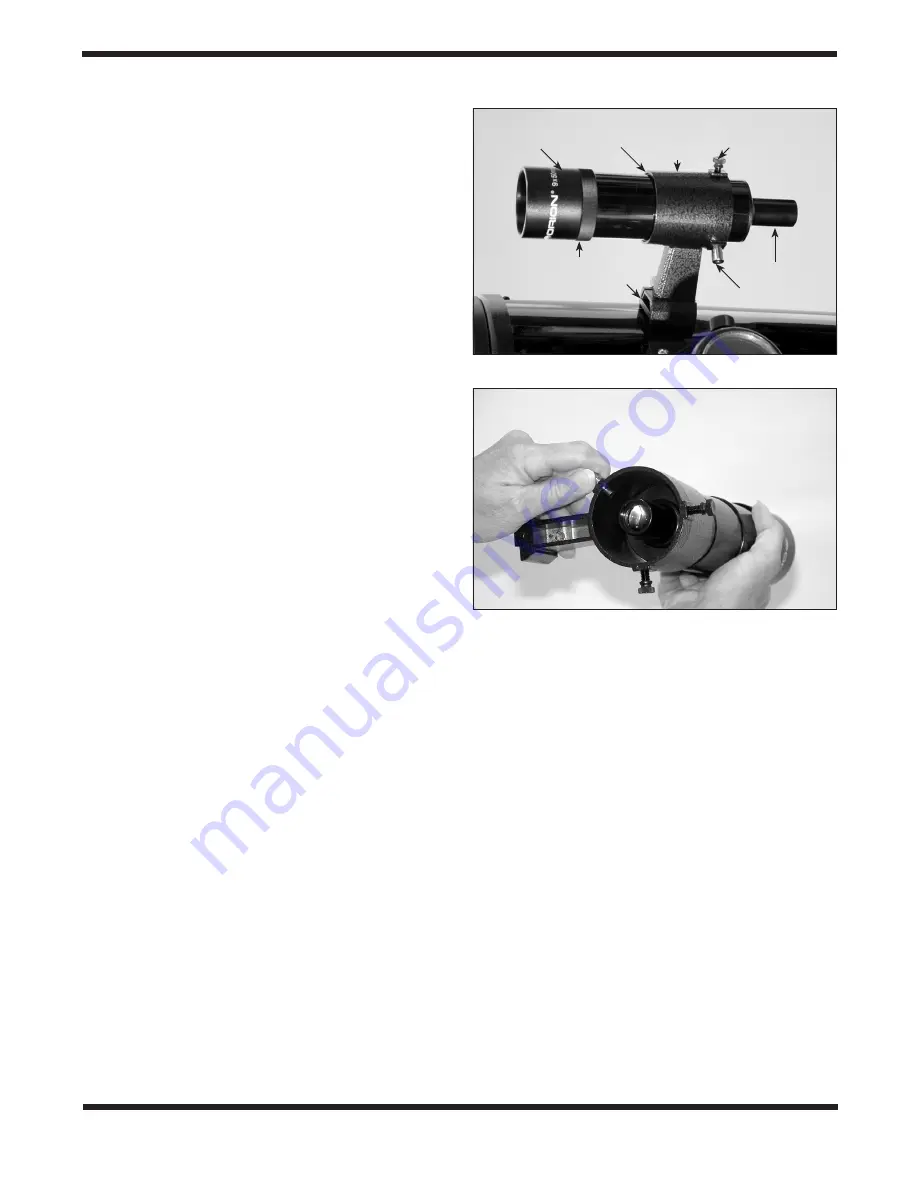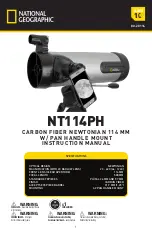
4
Attaching the Finder Scope
The included 9x50 crosshair finder scope
(Figure 3a) is use-
ful for locating objects in the sky and centering them in the
main telescope’s field of view.
To install it, first remove the O-ring from the bracket and place
it over the body of the finder scope until it seats in the narrow
groove near the middle of the finder. Unthread the two black
nylon alignment screws on the bracket until the screw ends
are flush with the inside surface of the bracket. Slide the eye-
piece end (narrow end) of the finder scope into the end of the
bracket’s cylinder opposite the alignment screws while pull-
ing the chrome, spring-loaded tensioning pin on the bracket
with your fingers
(Figure 3b). Push the finder scope through
the bracket until the O-ring seats just inside the front opening.
Release the tensioner and tighten the two black nylon screws
a couple of turns each to secure the finder scope in place.
The tips of the tensioner and nylon screws should seat into
the wide groove on the finder scope’s body.
Now slide the foot of the finder scope bracket into the dovetail
base on the main telescope. You’ll first have to back out the
thumbscrew lock on the dovetail base a few turns to allow the
bracket to slide in. Once the bracket is inserted, tighten the
thumbscrew lock.
Aligning the Finder Scope
The finder scope and the main telescope must be aligned so
they point to exactly the same spot in the sky. Alignment is
easiest to do in daylight. First, insert an eyepiece (a crosshair
eyepiece is best) into the eyepiece holder in the telescope’s
focuser. Point the telescope at an object such as the top of
a telephone pole or a street sign that is at least a quarter-
mile away. Move the telescope so the target object appears
in the very center of the field of view when you look into the
eyepiece.
Now look through the finder scope. Is the object centered
in the finder scope’s field of view? If not, hopefully it will be
visible somewhere in the field of view, so that only a minor
adjustment of the finder scope’s two alignment screws will be
needed to center it. Otherwise you’ll have to make coarser
adjustments to redirect the aim of the finder scope.
Once the target object is centered on the crosshairs of the
finder scope, look again in the telescope’s eyepiece and see
if it is still centered there as well. If it isn’t, repeat the entire
process, making sure not to move the telescope while adjust-
ing the alignment of the finder scope. When the target object
is centered on the crosshairs of the finder scope and in the
telescope’s eyepiece, the finder scope is aligned and ready to
be used for locating objects.
The finder scope alignment should be checked before every
imaging or observing session. This can easily be done at
night, before viewing through the telescope. Choose any
bright star or planet, center the object in the telescope eye-
piece, and then adjust the bracket’s alignment screws until
the star or planet is also centered on the finder’s crosshairs.
Focusing the Finder Scope
If the image in the finder scope appears out of focus, you will
need to refocus the finder scope for your vision. First, loosen
the lock ring located behind the objective lens cell on the body
of the finder scope
(Figure 3a). Back the lock ring off by a few
turns. Then refocus the finder scope on a distant object by
rotating the objective lens cell clockwise or counterclockwise.
Once the image appears sharp, retighten the lock ring behind
the objective lens cell. The finder scope’s focus should not
need to be adjusted again.
2. Operating Your Orion
f/3.9 Newtonian
Astrograph
Your Orion f/3.9 Newtonian Astrograph is designed primar-
ily for astro-imaging, but it makes a fine visual instrument as
well. For visual use, we recommend using high-quality eye-
pieces to take full advantage of the instrument’s exceptional
optical quality. For imaging applications, the telescope is opti-
mized for use with an APS-C or smaller size sensor, found in
such cameras as the Orion StarShoot
™
Pro, Orion Parsec
™
,
and many DSLRs.
Figure 3b.
Pull back the spring tensioning pin and slide the finder
scope into its bracket until the O-ring is seated in the bracket ring.
Figure 3a.
The 9x50 finder scope and bracket
Tensioner pin
Eyepiece
Nylon alignment
thumbscrew (2)
Focusing lock ring
Dovetail base
Finder
scope
O-ring
(not visible)
Finder
scope
bracket



















